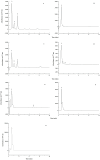Metabolic Engineering of Escherichia coli for Producing Astaxanthin as the Predominant Carotenoid
- PMID: 28937591
- PMCID: PMC5666404
- DOI: 10.3390/md15100296
Metabolic Engineering of Escherichia coli for Producing Astaxanthin as the Predominant Carotenoid
Abstract
Astaxanthin is a carotenoid of significant commercial value due to its superior antioxidant potential and wide applications in the aquaculture, food, cosmetic and pharmaceutical industries. A higher ratio of astaxanthin to the total carotenoids is required for efficient astaxanthin production. β-Carotene ketolase and hydroxylase play important roles in astaxanthin production. We first compared the conversion efficiency to astaxanthin in several β-carotene ketolases from Brevundimonas sp. SD212, Sphingomonas sp. DC18, Paracoccus sp. PC1, P. sp. N81106 and Chlamydomonas reinhardtii with the recombinant Escherichia coli cells that synthesize zeaxanthin due to the presence of the Pantoea ananatis crtEBIYZ. The B. sp. SD212 crtW and P. ananatis crtZ genes are the best combination for astaxanthin production. After balancing the activities of β-carotene ketolase and hydroxylase, an E. coli ASTA-1 that carries neither a plasmid nor an antibiotic marker was constructed to produce astaxanthin as the predominant carotenoid (96.6%) with a specific content of 7.4 ± 0.3 mg/g DCW without an addition of inducer.
Keywords: Escherichia coli; astaxanthin; metabolic engineering; β-carotene hydroxylase; β-carotene ketolase.
Conflict of interest statement
The authors declare no conflicts of interest.
Figures


References
-
- Lee P.C., Schmidt-Dannert C. Metabolic engineering towards biotechnological production of carotenoids in microorganisms. Appl. Microbiol. Biotechnol. 2002;60:1–11. - PubMed
MeSH terms
Substances
LinkOut - more resources
Full Text Sources
Other Literature Sources
Research Materials
Miscellaneous

